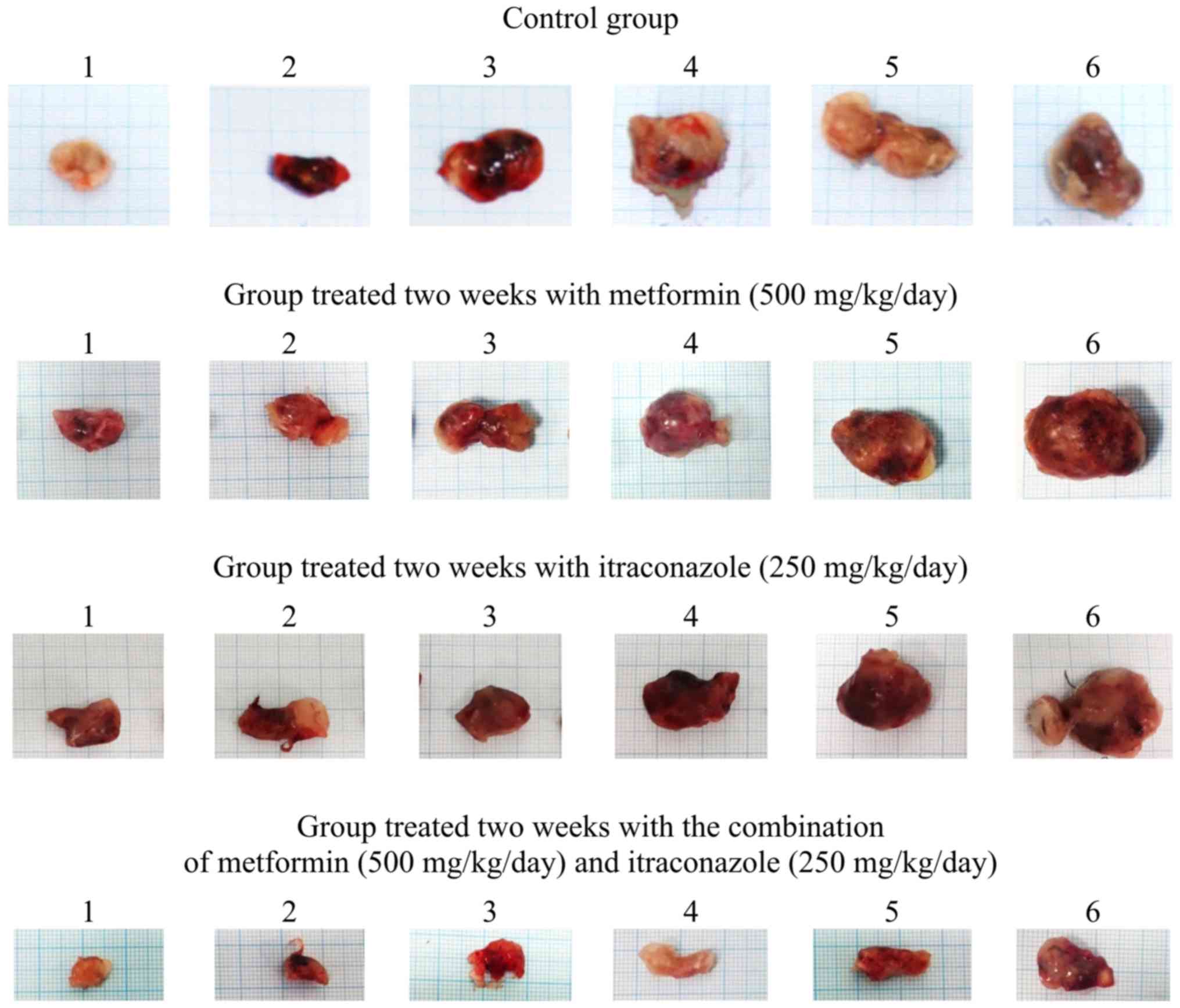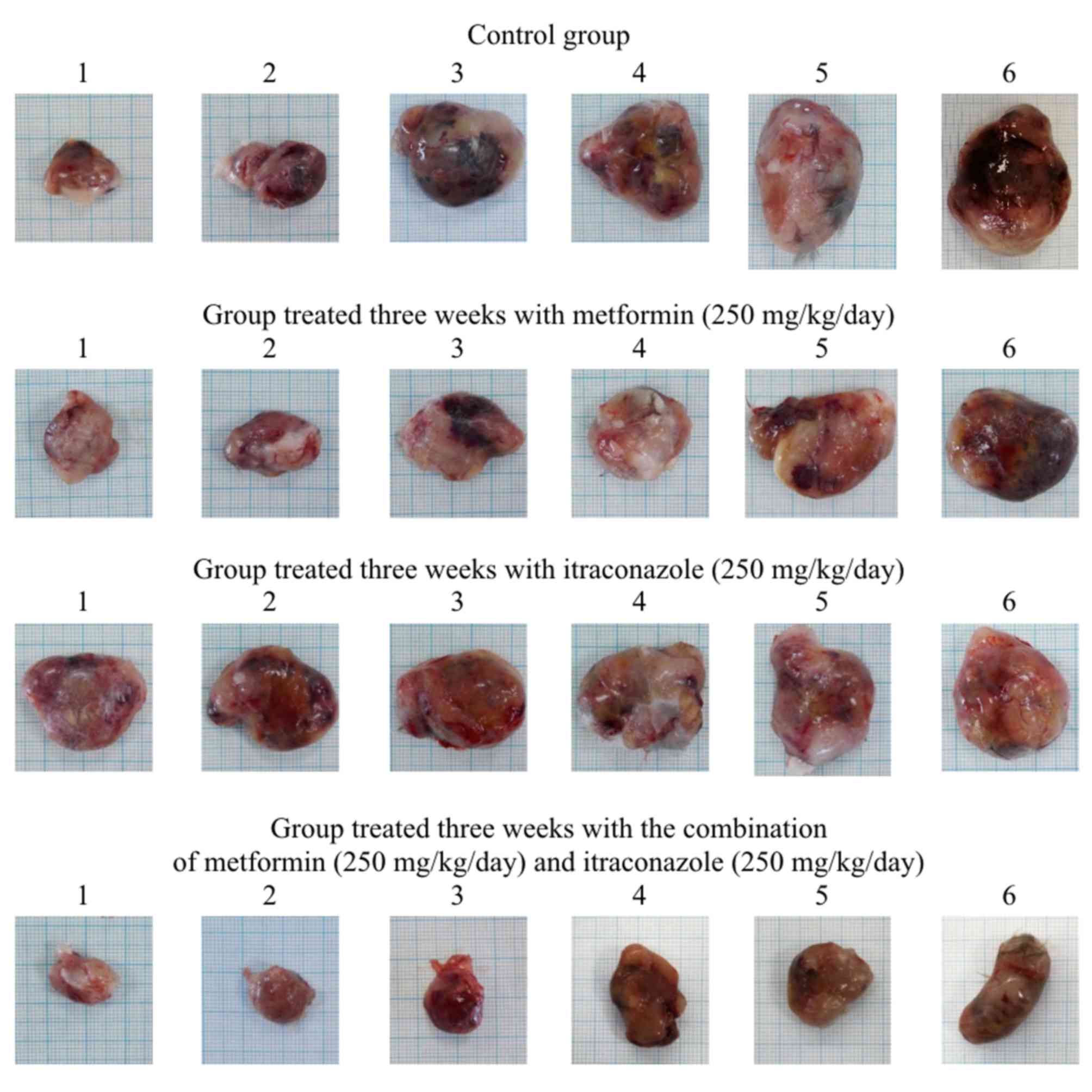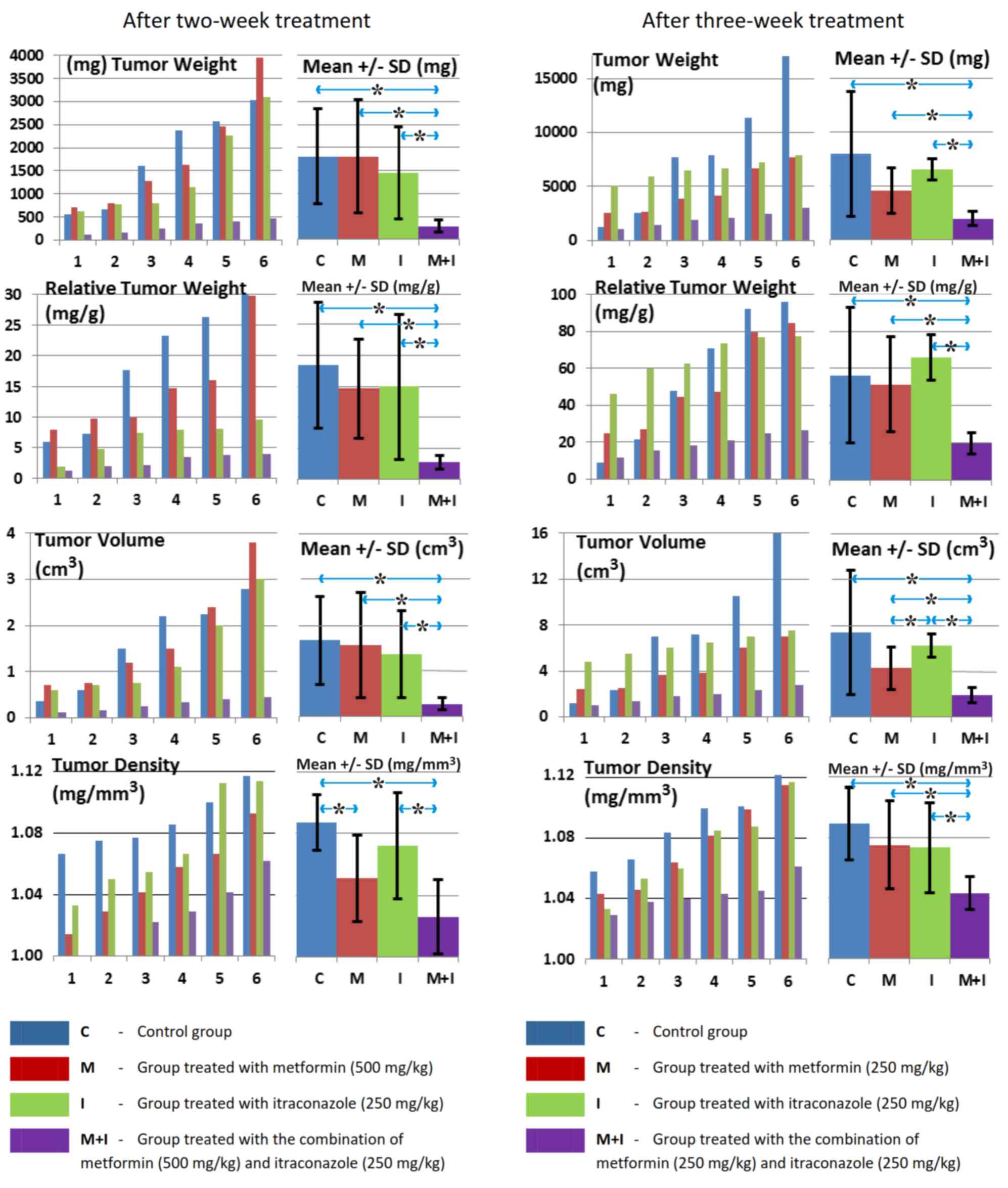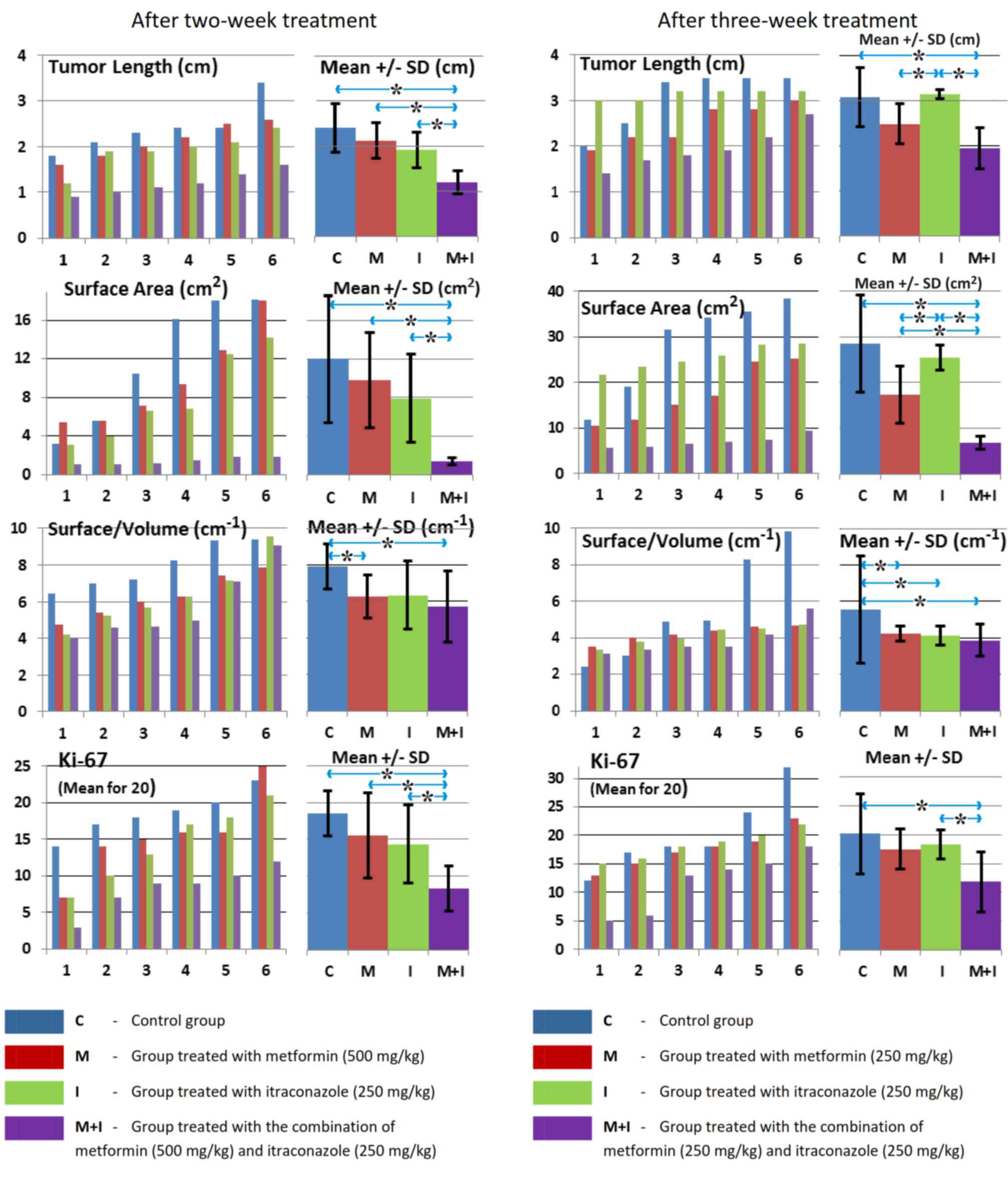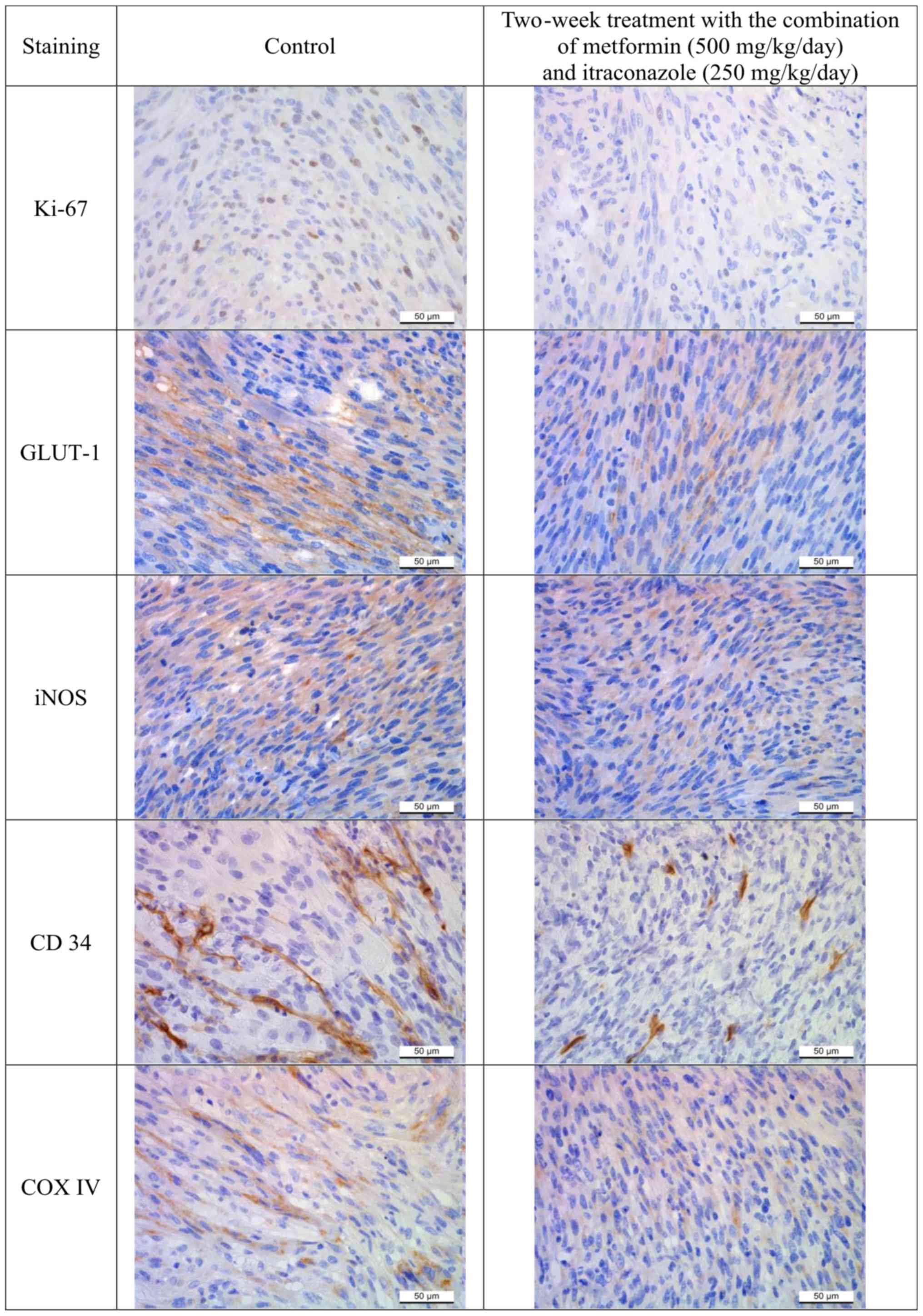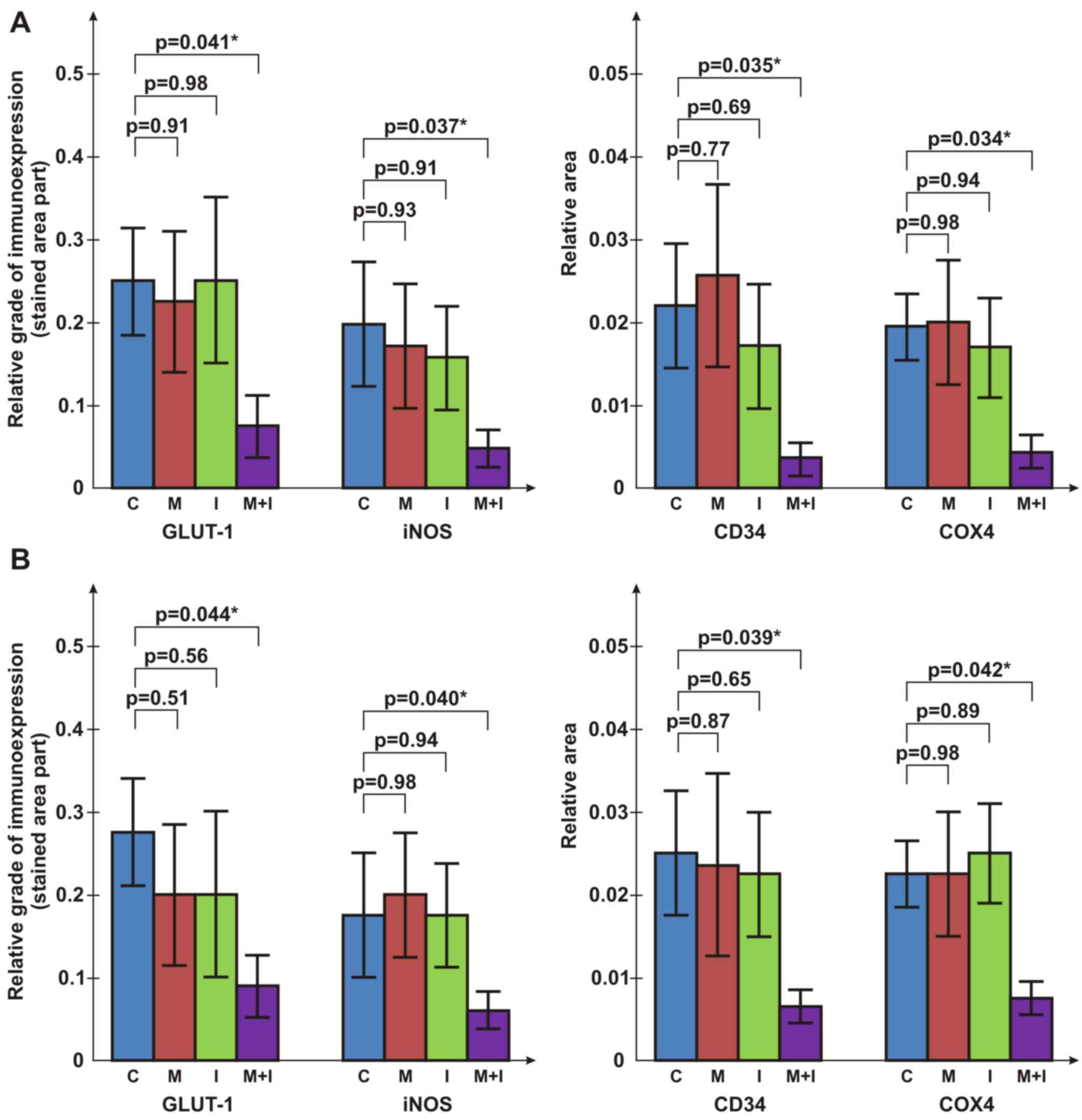|
1
|
Park SY, Kim D and Kee SH:
Metformin-activated AMPK regulates β-catenin to reduce cell
proliferation in colon carcinoma RKO cells. Oncol Lett.
17:2695–2702. 2019.PubMed/NCBI
|
|
2
|
Zi F, Zi H, Li Y, He J, Shi Q and Cai Z:
Metformin and cancer: An existing drug for cancer prevention and
therapy. Oncol Lett. 15:683–690. 2018.PubMed/NCBI
|
|
3
|
Popović DJ, Lalošević D, Miljković D,
Popović KJ, Čapo I and Popović JK: Effect of metformin on
fibrosarcoma in hamsters. Eur Rev Med Pharmacol Sci. 21:5499–5505.
2017.PubMed/NCBI
|
|
4
|
Meng XM, Ma XX, Tian YL, Jiang Q, Wang LL,
Shi R, Ding L and Pang SG: Metformin improves the glucose and lipid
metabolism via influencing the level of serum total bile acids in
rats with streptozotocin-induced type 2 diabetes mellitus. Eur Rev
Med Pharmacol Sci. 21:2232–2237. 2017.PubMed/NCBI
|
|
5
|
Salis O, Bedir A, Ozdemir T, Okuyucu A and
Alacam H: The relationship between anticancer effect of metformin
and the transcriptional regulation of certain genes (CHOP, CAV-1,
HO-1, SGK-1 and Par-4) on MCF-7 cell line. Eur Rev Med Pharmacol
Sci. 18:1602–1609. 2014.PubMed/NCBI
|
|
6
|
Purchiaroni F, Galli G and Annibale B:
Metformin plus proton pump inhibitors therapy: The cobalamin
deficiency challenge. Eur Rev Med Pharmacol Sci. 19:2501–2502.
2015.PubMed/NCBI
|
|
7
|
Yang Y and Wu XH: Study on the influence
of metformin on castration-resistant prostate cancer PC-3 cell line
biological behavior by its inhibition on PLCε gene-mediated
Notch1/Hes and androgen receptor signaling pathway. Eur Rev Med
Pharmacol Sci. 21:1918–1923. 2017.PubMed/NCBI
|
|
8
|
Zhou HY, Zhu H, Yao XM, Qian JP, Yang J,
Pan XD and Chen XD: Metformin regulates tight junction of
intestinal epithelial cells via MLCK-MLC signaling pathway. Eur Rev
Med Pharmacol Sci. 21:5239–5246. 2017.PubMed/NCBI
|
|
9
|
Tan JS and Joseph WS: Common fungal
infections of the feet in patients with diabetes mellitus. Drugs
Aging. 21:101–112. 2004. View Article : Google Scholar : PubMed/NCBI
|
|
10
|
Gupta AK, Gover MD and Lynde CW: Pulse
itraconazole vs. continuous terbinafine for the treatment of
dermatophyte toenail onychomycosis in patients with diabetes
mellitus. J Eur Acad Dermatol Venereol. 20:1188–1193. 2006.
View Article : Google Scholar : PubMed/NCBI
|
|
11
|
Tsubamoto H, Ueda T, Inoue K, Sakata K,
Shibahara H and Sonoda T: Repurposing itraconazole as an anticancer
agent. Oncol Lett. 14:1240–1246. 2017. View Article : Google Scholar : PubMed/NCBI
|
|
12
|
Navarro-Martínez MD, Cabezas-Herrera J and
Rodríguez-López JN: Antifolates as antimycotics? Connection between
the folic acid cycle and the ergosterol biosynthesis pathway in
Candida albicans. Int J Antimicrob Agents. 28:560–567. 2006.
View Article : Google Scholar : PubMed/NCBI
|
|
13
|
Pace JR, DeBerardinis AM, Sail V,
Tacheva-Grigorova SK, Chan KA, Tran R, Raccuia DS, Wechsler-Reya RJ
and Hadden MK: Repurposing the clinically efficacious Anti-fungal
agent itraconazole as an anti-cancer chemotherapeutic. J Med Chem.
59:3635–3649. 2016. View Article : Google Scholar : PubMed/NCBI
|
|
14
|
Hu Q, Hou YC, Huang J, Fang JY and Xiong
H: Itraconazole induces apoptosis and cell cycle arrest via
inhibiting Hedgehog signaling in gastric cancer cells. J Exp Clin
Cancer Res. 36:502017. View Article : Google Scholar : PubMed/NCBI
|
|
15
|
Choi YH, Lee U, Lee BK and Lee MG:
Pharmacokinetic interaction between itraconazole and metformin in
rats: Competitive inhibition of metabolism of each drug by each
other via hepatic and intestinal CYP3A1/2. Br J Pharmacol.
161:815–829. 2010. View Article : Google Scholar : PubMed/NCBI
|
|
16
|
Bondarenko LB, Shayakhmetova GM, Voronina
AK and Kovalenko VM: Effects of metformin on cytochromes CYP3А,
CYP2С and CYP2Е1 Functioning at metabolic syndrome in rats of
different age. Curr Res Diabetes Obes J. 4:5556452017.
|
|
17
|
Pakkir Maideen NM, Jumale A and
Balasubramaniam R: Drug interactions of metformin involving drug
transporter proteins. Adv Pharm Bull. 7:501–505. 2017. View Article : Google Scholar : PubMed/NCBI
|
|
18
|
Wagner DJ, Hu T and Wang J: Polyspecific
organic cation transporters and their impact on drug intracellular
levels and pharmacodynamics. Pharmacol Res. 111:237–246. 2016.
View Article : Google Scholar : PubMed/NCBI
|
|
19
|
König J, Müller F and Fromm MF:
Transporters and drug-drug interactions: Important determinants of
drug disposition and effects. Pharmacol Rev. 65:944–966. 2013.
View Article : Google Scholar : PubMed/NCBI
|
|
20
|
Quesada J and Amato R: The molecular
biology of Soft-tissue sarcomas and current trends in therapy.
Sarcoma. 2012:8494562012. View Article : Google Scholar : PubMed/NCBI
|
|
21
|
Anderson JL, Denny CT, Tap WD and Federman
N: Pediatric sarcomas: Translating molecular pathogenesis of
disease to novel therapeutic possibilities. Pediatr Res.
72:112–121. 2012. View Article : Google Scholar : PubMed/NCBI
|
|
22
|
Issaq SH, Teicher BA and Monks A:
Bioenergetic properties of human sarcoma cells help define
sensitivity to metabolic inhibitors. Cell Cycle. 13:1152–1161.
2014. View
Article : Google Scholar : PubMed/NCBI
|
|
23
|
Hoang NT, Acevedo LA, Mann MJ and Tolani
B: A review of soft-tissue sarcomas: Translation of biological
advances into treatment measures. Cancer Manag Res. 10:1089–1114.
2018. View Article : Google Scholar : PubMed/NCBI
|
|
24
|
Burningham Z, Hashibe M, Spector L and
Schiffman JD: The epidemiology of sarcoma. Clin Sarcoma Res.
2:142012. View Article : Google Scholar : PubMed/NCBI
|
|
25
|
Calvert GT, Randall RL, Jones KB,
Cannon-Albright L, Lessnick S and Schiffman JD: At-Risk populations
for osteosarcoma: The syndromes and beyond. Sarcoma.
2012:1523822012. View Article : Google Scholar : PubMed/NCBI
|
|
26
|
Egas-Bejar D and Huh WW: Rhabdomyosarcoma
in adolescent and young adult patients: Current perspectives.
Adolesc Health Med Ther. 5:115–125. 2014.PubMed/NCBI
|
|
27
|
Stoker M and Macpherson I: Syrian hamster
fibroblast cell line BHK21 and its derivatives. Nature.
203:1355–1357. 1964. View Article : Google Scholar : PubMed/NCBI
|
|
28
|
Mayo J, Lombardo L, Klein-Szanto AJ, Conti
CJ and Moreira JL: An oncogenic virus carried by hamster kidney
cells. Cancer Res. 33:2273–2277. 1973.PubMed/NCBI
|
|
29
|
Tomayko MM and Reynolds CP: Determination
of subcutaneous tumor size in athymic (nude) mice. Cancer Chemother
Pharmacol. 24:148–154. 1989. View Article : Google Scholar : PubMed/NCBI
|
|
30
|
Sápi J, Kovács L, Drexler DA, Kocsis P,
Gajári D and Sápi Z: Tumor volume estimation and quasi-continuous
administration for most effective bevacizumab therapy. PLoS One.
10:e01421902015. View Article : Google Scholar : PubMed/NCBI
|
|
31
|
Kanto K, Ito H, Noso S, Babaya N, Hiromine
Y, Taketomo Y, Toma J, Niwano F, Yasutake S, Kawabata Y and Ikegami
H: Effects of dosage and dosing frequency on the efficacy and
safety of high-dose metformin in Japanese patients with type 2
diabetes mellitus. J Diabetes Investig. Sep 30–2017.(Epub ahead of
print). PubMed/NCBI
|
|
32
|
de Sousa ATO, Vasconcelos JMB and Soares
MJGO: Software Image Tool 3.0 as an instrument for measuring
wounds. J Nurs UFPE on line. 6:2569–2573. 2012.(In English;
Portuguese).
|
|
33
|
Scudiero DA, Shoemaker RH, Paull KD, Monks
A, Tierney S, Nofziger TH, Currens MJ, Seniff D and Boyd MR:
Evaluation of a soluble tetrazolium/formazan assay for cell growth
and drug sensitivity in culture using human and other tumor cell
lines. Cancer Res. 48:4827–4833. 1988.PubMed/NCBI
|
|
34
|
Campbell BC, Chan KL and Kim JH:
Chemosensitization as a means to augment commercial antifungal
agents. Front Microbiol. 3:792012. View Article : Google Scholar : PubMed/NCBI
|
|
35
|
Singh V and Singh SM: Effect of high cell
density on the growth properties of tumor cells: A role in tumor
cytotoxicity of chemotherapeutic drugs. Anticancer Drugs.
18:1123–1132. 2007. View Article : Google Scholar : PubMed/NCBI
|
|
36
|
No authors listed, . (P097) tumor density,
size, and histology in the outcome of stereotactic body radiation
therapy for early-stage non-small-cell lung cancer: a
single-institution experience. Oncology (Williston Park). 29 (Suppl
1):(pii): 2050532015.PubMed/NCBI
|
|
37
|
Dowling RJ, Lam S, Bassi C, Mouaaz S, Aman
A, Kiyota T, Al-awar R, Goodwin PJ and Stambolic V: Metformin
pharmacokinetics in mouse tumors: Implications for human therapy.
Cell Metab. 23:567–568. 2016. View Article : Google Scholar : PubMed/NCBI
|
|
38
|
Cheong JH, Park ES, Liang J, Dennison JB,
Tsavachidou D, Nguyen-Charles C, Wa Cheng K, Hall H, Zhang D, Lu Y,
et al: Dual inhibition of tumor energy pathway by 2-deoxyglucose
and metformin is effective against a broad spectrum of preclinical
cancer models. Mol Cancer Ther. 10:2350–2362. 2011. View Article : Google Scholar : PubMed/NCBI
|
|
39
|
Kim J, Tang JY, Gong R, Kim J, Lee JJ,
Clemons KV, Chong CR, Chang KS, Fereshteh M, Gardner D, et al:
Itraconazole, a commonly used antifungal that inhibits Hedgehog
pathway activity and cancer growth. Cancer Cell. 17:388–399. 2010.
View Article : Google Scholar : PubMed/NCBI
|
|
40
|
Choi CH, Ryu JY, Cho YJ, Jeon HK, Choi JJ,
Ylaya K, Lee YY, Kim TJ, Chung JY, Hewitt SM, et al: The
anti-cancer effects of itraconazole in epithelial ovarian cancer.
Sci Rep. 7:65522017. View Article : Google Scholar : PubMed/NCBI
|
|
41
|
Zhang L, Liu Z, Yang K, Kong C, Liu C,
Chen H, Huang J and Qian F: Tumor progression of non-small cell
lung cancer controlled by albumin and Micellar nanoparticles of
Itraconazole, a Multitarget angiogenesis inhibitor. Mol Pharm.
14:4705–4713. 2017. View Article : Google Scholar : PubMed/NCBI
|
|
42
|
Hwang YP and Jeong HG: Metformin blocks
migration and invasion of tumour cells by inhibition of matrix
metalloproteinase-9 activation through a calcium and protein kinase
Calpha-dependent pathway:
Phorbol-12-myristate-13-acetate-induced/extracellular
signal-regulated kinase/activator protein-1. Br J Pharmacol.
160:1195–1211. 2010. View Article : Google Scholar : PubMed/NCBI
|















